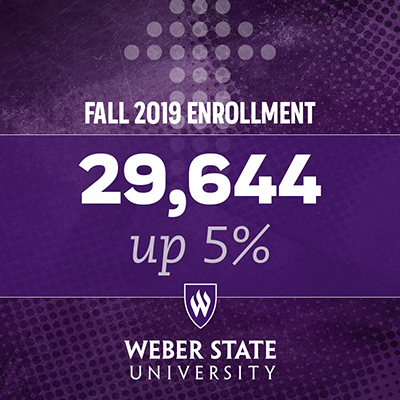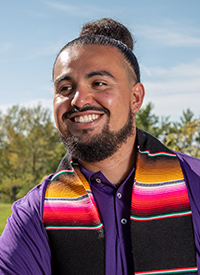Record Number of Hispanic, Concurrent Enrollment Students at WSU
OGDEN, Utah – Since 2015, the number of Hispanic students at Weber State University has increased 31%; the number of concurrent enrollment (CE) students, those taking university courses while in high school, has increased almost 46%, and the number of Hispanic concurrent enrollment students has jumped 56%.
 According to the annual third-week fall head count, the total enrollment at Weber State stands at 29,644, an increase of nearly 5% from the 2018 enrollment of 28,247.
According to the annual third-week fall head count, the total enrollment at Weber State stands at 29,644, an increase of nearly 5% from the 2018 enrollment of 28,247.
In addition, Weber State awarded a record 5,615 certificates, associate’s, bachelor’s and graduate degrees in 2019; 22% of those to students of Hispanic or Latino descent.
“Weber State has worked very hard to represent the community where our students live,” said President Brad Mortensen. “We have consistently invested in the people and resources to provide access to learning to every member of the community no matter where they are in their educational journey.”
According to the five-year U.S. Census average, the percentage of Hispanic citizens living in Davis, Weber and Morgan counties is 12.7%, and Weber State’s total Hispanic population is 11%. The university’s mission is to reflect the community, and the work to prepare students for higher education begins early.
Concurrent enrollment courses not only provide college credit at an extraordinary value, they also help high school students enter higher education in a familiar setting with the peers they know.
At Ben Lomond High School, Cristian Gutierrez took 19 concurrent enrollment credits in U.S. history, principles of engineering, physics and digital electronics. He strongly preferred the CE model to Advanced Placement (AP) classes. In AP courses, students may pass the class, but fail the test at the end and not receive credit. Students in CE know whatever grade they earn in class will carry over to their college transcript.
“AP favors those who excel with test-taking skills,” Gutierrez said. “In my opinion, many students of color, especially those of us who are first generation and from minority households, might lack those skills because our parents weren’t able to help us early. CE is more equitable to all students.”
 Gutierrez, who graduated from Weber State in spring 2019, said his CE courses allowed him an inexpensive option to explore general education credits before arriving at the university.
Gutierrez, who graduated from Weber State in spring 2019, said his CE courses allowed him an inexpensive option to explore general education credits before arriving at the university.
“CE opened my eyes and let me know I was ready for Weber State and what it had to offer,” Gutierrez said. “The professors were really good. They weren’t easy classes. We were meticulously graded. Our papers were torn apart, but coming here and knowing I had passed classes at a college level, I felt ready.”
According to a Utah System of Higher Education report, “Of low-income students, (defined as students participating in the free or reduced lunch program) those who participated in concurrent enrollment went to college at twice the rate of those who did not participate.”
Weber State’s Admissions office and the Student Success Center guide students in academic advising as part of the university’s commitment to offering university opportunities to high school students. That individual attention helps explain the yearly growth.
“Weber State departments such as math and English help first-generation and Hispanic students overcome some of the fears and anxieties of enrolling in college by offering courses those students could complete while in the comfortable surroundings of a high school environment,” said Beth Rhoades, Continuing Education programs director. “The high school administrators have worked with teachers to help them become qualified to teach concurrent enrollment, and counseling offices have consciously had conversations with parents and students to introduce them to college options early in their high school years."
It is recommended concurrent enrollment students be in their junior or senior years and have a GPA or 3.0 or better.
Katlynn Kunz graduated from Fremont High School in May 2018 with 23 college credits. She is now working on an associate’s in general studies.
“I loved that I could take college credit in high school but still be able to participate in high school activities when I wanted to,” Kunz said. “I feel like since the class was a little bit smaller, I was able to be more interactive with my teachers and the other students. Teachers were able to give me specific help when I asked for it. The classes were challenging, and I had to work at them, but the comfort of my high school surroundings really helped me succeed.”
For photos, visit the following links.
Visit weber.edu/wsutoday for more news about Weber State University.
Allison Barlow Hess, Public Relations director
801-626-7948 • ahess@weber.edu